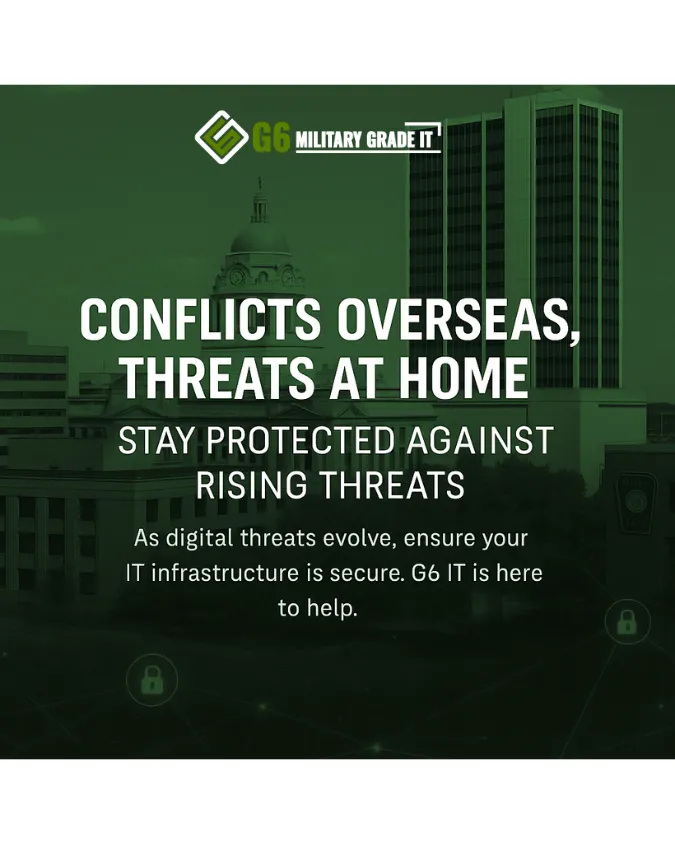
G6 IT Tips: The Iran-Israel Conflict Is Fueling a Cyber Storm
Is Your Organization Ready?
Why U.S. Infrastructure, Government, and Business Leaders Should Pay Attention Now
By the G6 Cyber Defense Team
🌐Global Conflicts Are Sparking Local Threats—Here’s What You Need to Know
The Iran-Israel conflict is dominating international headlines. But what’s not being reported nearly enough is what’s happening beneath the surface—in our networks, our systems, and our communities.
The Department of Homeland Security just issued a new bulletin (June 2025), warning of a heightened threat environment tied directly to this escalating conflict. The ripple effect?
{American organizations—public and private—are increasingly at risk of cyber and physical attacks.}
If you lead IT, security, or operations for a city, school, department, or business… this isn’t just news. It’s a flashing red warning light.
🧭 A Conflict Abroad, A Shared Responsibility at Home
The Iran-Israel conflict is complex—and opinions vary. But no matter how you interpret the politics, one thing remains constant:
{Threat actors are using this moment to exploit vulnerabilities across U.S. networks, systems, and institutions.}
At G6, we work with local governments, first responders, school systems, and businesses—and every one of them faces the same reality:
Cybersecurity doesn’t care about opinions. It only cares about preparation.
You don’t need to agree on the headlines to agree on this: keeping your team, systems, and data safe matters now more than ever.
⏳ Conflict, Cyber Warfare, and a Pattern We Can’t Ignore
This isn’t the first time tensions with Iran have translated into digital chaos here at home. In fact, history shows us what happens when hostile regimes ramp up aggression:
2012–2013: Iranian-backed hackers launched a wave of DDoS attacks against top U.S. banks—crippling digital banking nationwide.
2014: After controversial remarks by a U.S. business leader, Iranian cyber operatives wiped servers and leaked sensitive data from Las Vegas Sands.
2020 and beyond: Following the death of an Iranian military figure, plots to target U.S. government personnel and critics on American soil began surfacing—and continue today.
Now, in 2025, amid the volatile Iran-Israel conflict, DHS warns that cyber actors affiliated with Iran are once again mobilizing—and calling for action against perceived enemies, including targets within the U.S.
🚧What DHS Is Telling Us (and Why It Matters)
The June 2025 DHS National Terrorism Advisory Bulletin outlines a serious threat landscape that includes:
Pro-Iranian hacktivist campaigns targeting U.S. networks
State-sponsored actors exploiting weak infrastructure
Ideological violence fueled by calls for retaliation
Hate crimes linked to anti-Semitic or anti-Israel sentiment
Extremist messaging from groups like HAMAS and Hizballah, inciting violence against U.S. interests
If you’re running critical systems—or supporting public safety, education, health, or local government—you can’t afford to be caught off guard.
🛠️ DHS Advice Is a Start. But It’s Not Enough.
The federal government is urging basic readiness:
Report suspicious online and offline activity.
Secure exposed networks, patch outdated systems.
Train your teams to recognize phishing and social engineering.
Follow CISA’s cybersecurity best practices.
These are good first steps. But let’s be honest: for many organizations, this is the minimum—not the solution.
🔐 G6 Cybersecurity Game Plan: Practical Steps for a Volatile Threat Landscape
At G6, we’re working closely with our partners in law enforcement, local government, education, and small business to proactively address the risks associated with the Iran-Israel conflict. Here's what we're helping them implement:
Cloud-based endpoint detection and response (EDR/MDR) with 24/7 monitoring
Backup and disaster recovery protocols that can be activated quickly
Strengthened email defenses and realistic phishing awareness exercises
Zero Trust network designs to reduce internal risk exposure
Credential and dark web monitoring to identify leaks early
Tabletop exercises to prepare leadership for real-world cyber events
As tensions rise globally, ensuring foundational readiness now can make all the difference later. These are measured, strategic moves to help organizations stay ahead of uncertainty.
👉Schedule a readiness review with G6
– The G6 Team

